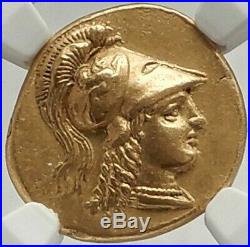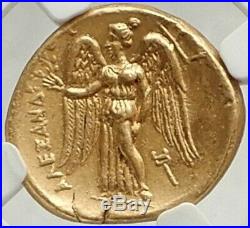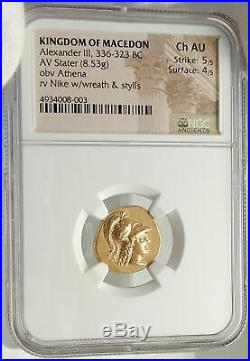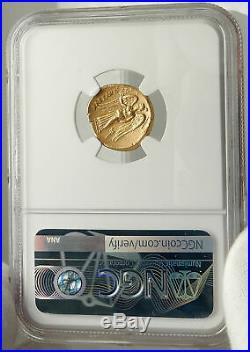




[6775] Macedonian Kingdom Alexander III the Great – King of Macedonia: 336-323 B. Gold Stater 18mm (8.53 grams) Tarsos mint. Struck under Balakros or Menes, circa 332/1-327 B. Reference: Price 3458; Muller 205 Certifiaction: NGC Ancients Ch AU Strike: 5/5 Surface: 4/5 4934008-003 Head of Athena right, wearing crested Corinthian helmet pushed back on head, the bowl decorated with griffin right. BAIE / AEANPOY, Nike standing left, holding wreath in extended right hand and cradling stylis in left arm; kerykeion below right wing. From the earliest series of staters of Alexander. This issue was originally given to Sidon by Newell, along with seven other issues of staters (and two distaters) that lacked the mint signature and/or date that is found on nearly all other issues at Sidon. Newell later doubted the attribution, and suggested they may belong to an early mint at Damaskos cf. Hill, “Alexander the Great and the Persian lion-gryphon, ” JHS 43 [1923], p. While Price retained Newell’s original attribution, he, too, remained skeptical Price, p. Le Rider, in his recent review of the coinage of Alexander the Great (Alexander the Great: Coinage, Finances, and Policy [Philadelphia, 2007]), recounted the various arguments, but also assimilated more recent research, and convincingly argues that these eight issues of gold actually were the first issues of Alexander type staters at the mint of Tarsos Le Rider, op. The reattribution to Tarsos has a significant effect on the importance of these staters. It is generally thought that Alexander began issuing his new coinage, staters of Athena/Nike type and tetradrachms of Herakles/Zeus type, shortly after his capture of Tarsos in 333 BC. Recognizing the importance of this mint for Alexander, supported by the state of the evidence at the time, Newell originally attributed a large series of staters to the early period of Alexanders at Tarsos E. Newell, “Tarsos under Alexander, ” AJN 52 [1918]. Later research, however, moved nearly all of these issues to a mint in Macedon cf. 371, and Troxell, Studies, pp. This void of gold coinage is therefore filled with the reattribution of the eight issues from Sidon, resulting in these being not only the first issue of Alexander staters from Tarsos, but the first issues of Alexander’s new stater coinage anywhere. Best known as Alexander the Great , he was a king (basileus in Greek) of the Ancient Greek kingdom of Macedonia. He was born in the city of Pella in 356 BC. By age 20, Alexander succeeded his father Philip II to the throne as king. He spent most of his years as king in an unprecedented military campaign of conquest through Asia, northeast Africa and even reached India. By age 30 he created one of the biggest empires in the ancient world, reaching from Greece to northwestern India. Being undefeated in battle, many consider him as one of history’s most successful military commanders. He could be considered one of history’s most important figures, having spread the Greek civilization far and wide, and was even admired by Julius Caesar along with many other important historical personages as well. Provided with certificate of authenticity. CERTIFIED AUTHENTIC by Sergey Nechayev, PhD – Numismatic Expert. Alexander III of Macedon (20/21 July 356 BC – 10/11 June 323 BC), commonly known as Alexander the Great , was a king (basileus) of the Ancient Greek kingdom of Macedon and a member of the Argead dynasty. Born in Pella in 356 BC, Alexander succeeded his father, Philip II, to the throne at the age of twenty. He spent most of his ruling years on an unprecedented military campaign through Asia and northeast Africa, and by the age of thirty he had created one of the largest empires of the ancient world, stretching from Greece to northwestern India. He was undefeated in battle and is widely considered one of history’s most successful military commanders. During his youth, Alexander was tutored by the philosopher Aristotle until the age of 16. After Philip’s assassination in 336 BC, Alexander succeeded his father to the throne and inherited a strong kingdom and an experienced army. Alexander was awarded the generalship of Greece and used this authority to launch his father’s Panhellenic project to lead the Greeks in the conquest of Persia. In 334 BC, he invaded the Achaemenid Empire, and began a series of campaigns that lasted ten years. Following the conquest of Asia Minor, Alexander broke the power of Persia in a series of decisive battles, most notably the battles of Issus and Gaugamela. He subsequently overthrew the Persian King Darius III and conquered the Achaemenid Empire in its entirety. At that point, his empire stretched from the Adriatic Sea to the Indus River. Seeking to reach the “ends of the world and the Great Outer Sea”, he invaded India in 326 BC, but eventually turned back at the demand of his homesick troops. Alexander died in Babylon in 323 BC, the city he planned to establish as his capital, without executing a series of planned campaigns that would have begun with an invasion of Arabia. In the years following his death, a series of civil wars tore his empire apart, resulting in several states ruled by the Diadochi, Alexander’s surviving generals and heirs. Alexander’s legacy includes the cultural diffusion his conquests engendered, such as Greco-Buddhism. He founded some twenty cities that bore his name, most notably Alexandria in Egypt. Alexander’s settlement of Greek colonists and the resulting spread of Greek culture in the east resulted in a new Hellenistic civilization, aspects of which were still evident in the traditions of the Byzantine Empire in the mid-15th century and the presence of Greek speakers in central and far eastern Anatolia until the 1920s. Alexander became legendary as a classical hero in the mold of Achilles, and he features prominently in the history and mythic traditions of both Greek and non-Greek cultures. He became the measure against which military leaders compared themselves, and military academies throughout the world still teach his tactics. He is often ranked among the most influential people in human history, along with his teacher Aristotle. The item “ALEXANDER III the GREAT Ancient LIFETIME 331BC Gold Greek Stater Coin NGC Ch AU” is in sale since Thursday, March 21, 2019. This item is in the category “Coins & Paper Money\Coins\ Ancient\Greek (450 BC-100 AD)”. The seller is “victoram” and is located in Forest Hills, New York. This item can be shipped worldwide.
- Culture: Greek
- Coin Type: Ancient
- Certification Number: 4934008-003
- Certification: NGC
- Grade: Ch AU
- Composition: Gold
- Denomination: Stater

